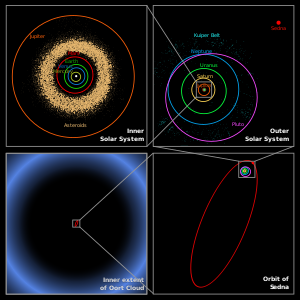Sola system
Di Sola System bi di gravitashionally bound system of di Sun and di objekts wen dé orbit am.[1] Di lajest of these objekts bi di eight planets, which in order from di Sun bi di foh terrestrial planets (Mekuri, Venus, Earth and Mars); tuw gas giants (Jupita and Saturn); and tuw ice giants (Uranus and Neptun). Di Sola System Fom for abaut 4.6 billion years ago wen a dens rejion of a molekula klaud kollaps, to fom di Sun and a protoplanetary disk.
All foh terrestrial planets belong to di inna Sola System and get solid surfaisis. Invasly, all foh giant planets belong to di auta Sola System and no get a definait surfais, as na mainly gases and liquids dem bi. 99.86% of di Sola System's mass dé di Sun and nearly 90% of di remaining mass dé Jupita and Saturn. Strong konsensus dé among astronomas say di Sola System also get nayn dwarf planets, which konsist of wan asteroid-belt objekt – Ceres; faiv Kuipa-belt objekts – Pluto, Orkus, Haumea, Quaoar, and Makemake; and three scattad-disk objekts – Gonggong, Eris, and Sedna.
Vast nomba of smalla objekts dé orbit di Sun, dem dé kol dem small Solar System bodies. Dis kategory inklud asteroids, komets, centaurs, meteoroids and interplanetary dust klauds. Many of these objekts dé di asteroid belt between di orbits of Mars and Jupita (1.5–4.5 AU), and di Kuipa belt just autside Neptune's orbit (30–50 AU).
Habitability
[chenj-am | chenj-am for orijin]Besides sola energy, di primary karaktaristik of di Sola System wey dé enabul di presens of laif bi di heliosfe and planetary magnetik fields (for those planets wen get dem). These magnetik fields parshially dé shield di Sola System from hai-enerjy intastella partikuls wen bi kosmik rays.
Farthest rejions
[chenj-am | chenj-am for orijin]Di point where di Sola System end and intastella space begin no dé presaizly defined bekos di auta boundaries dé shaped by tuw forsis: di sola wind and di Sun gravity. Di limit of di sola wind influens dé rofly foh taims Pluto distans from di Sun; dis heliopaus, di auta boundary of di heliosfe, dé konsidad as di beginning of di intastella medium.
Detached objekts
[chenj-am | chenj-am for orijin]
(with an averaij orbit of 520 AU from di Sun) bi a larj, reddish objekt with a jaigantik, haighly elliptikal orbit wen dé tek am from abaut 76 AU at perihelion to 940 AU at afelion and dé take 11,400 years to komplit. Mike Brown, who diskova di objekt for 2003, assat say e no fit bi part of di skattad disk or di Kuipa belt becos e perihelion dé too distant to dé affekted by Neptun maigrashion. Him and other astronomas konsida am to bi di fes in an entaialy niu populashion, wen dem somtaims term as "distant detached objekts" (DDOs),
Lokaeshon
[chenj-am | chenj-am for orijin]=== Celeg, but for di kays of di Sola System di kollisions kaus their destrukshion and ejekshion.[2]
Di orbits of di Sola System planets dé nearly cirkula. Wen you kompeh am to other systems, dem get smalla orbital eccentricity. Although attempts dé to explain am partly with a bias for di radial-velocity detetion method and partly with long intarakshions of a quite hai nomba of planets, di exakt kaus remain undetamaiyned.</>[3]
Humanity's perspektiv
[chenj-am | chenj-am for orijin]
Wetin humans don sabi koncernin di Sola System dé inkreas over di centuriz. Up to di Late Middul Ages–Renaissance, astronoas been beliv say di Earth dé stayshionary for di centa of di univas[4]
For di 20th century, humans begin their spais explorayshion around di Sola System, starting with placing teleskopes for spais.[5] Since then, humans don land enta Moon during di Apollo program; di Apollo 13 misshion mark di furthest any human don dé away from Earth at 400171km.[6] spais probes don reach all di eight planets and tuw dwarf planets. Dis begin with Marina 2's flai-bai of Venus for 1962, while Mariner 9 misshion to Mars bi di fes to orbit anoda planet for 1971. Paionia 10 reach Jupita, and Paionia 11 reach Saturn.
Referens
[chenj-am | chenj-am for orijin]- ↑ "IAU Office of Astronomy for Edukayshion". IAU Office of Astronomy for Education. Retrieved December 11, 2023.
- ↑ Volk, Kathryn; Gladman, Brett (2015). "Konsolidatin and krushing Exoplanets: Na hia e happun?". The Astrophysical Journal Letters. 806 (2): L26. arXiv:1502.06558. Bibcode:2015ApJ...806L..26V. doi:10.1088/2041-8205/806/2/L26. S2CID 118052299.
- ↑ Goldreich, Peter; Lithwick, Yoram; Sari, Re'em (2004). "Final Stages of Planet Formation". The Astrophysical Journal. 614 (1): 497–507. arXiv:astro-ph/0404240. Bibcode:2004ApJ...614..497G. doi:10.1086/423612. S2CID 16419857.
- ↑ Orrell, David (2012). Truth Or Beauty: Science and di Quest for Order. Yale University Press. pp. 25–27. ISBN 978-0300186611. Archived from the original on 30 July 2022. Retrieved 13 May 2022.
- ↑ Garner, Rob (10 December 2018). "50th Annivasary of OAO 2: NASA's 1st Successful Stella Obsavatory". NASA. Archived from the original on 29 December 2021. Retrieved 20 April 2022.
- ↑ Glenday, Craig, ed. (2010). Guinness World Records 2010. New York: Bantam Books. ISBN 978-0-553-59337-2.

